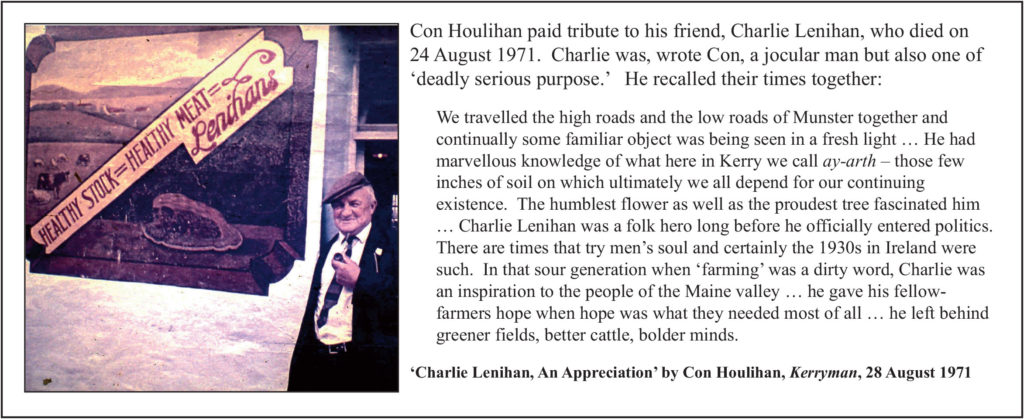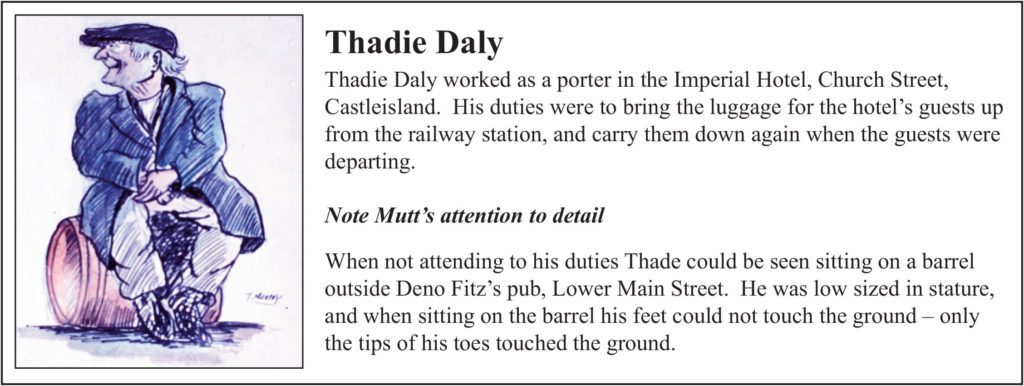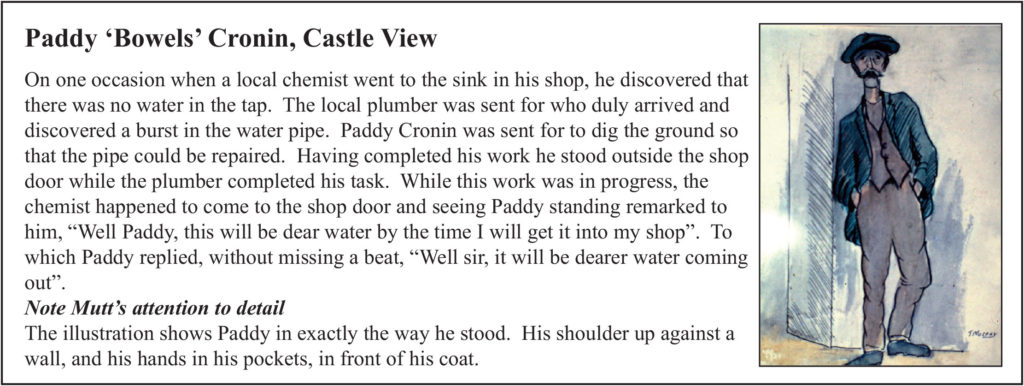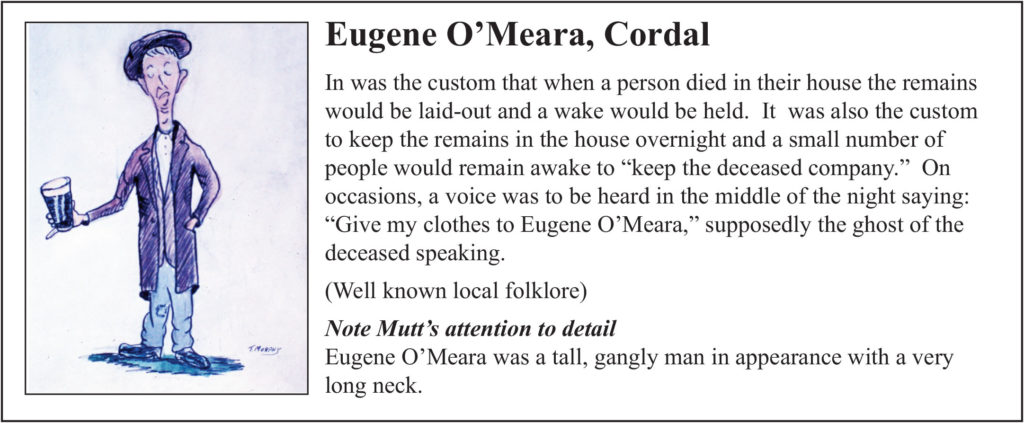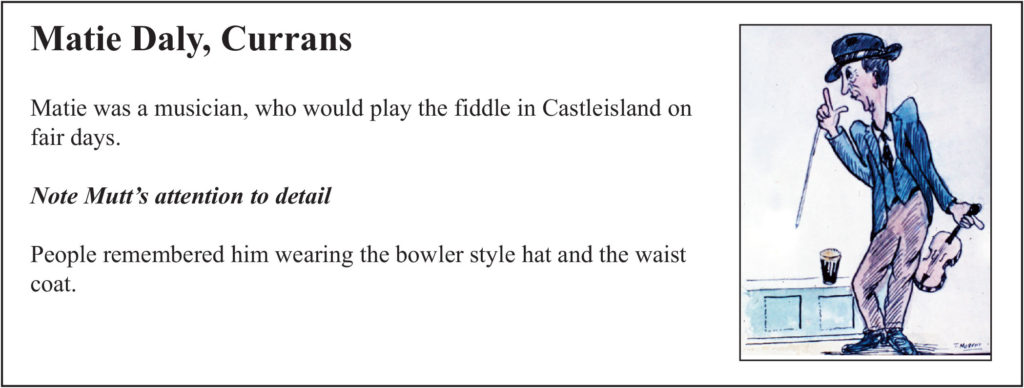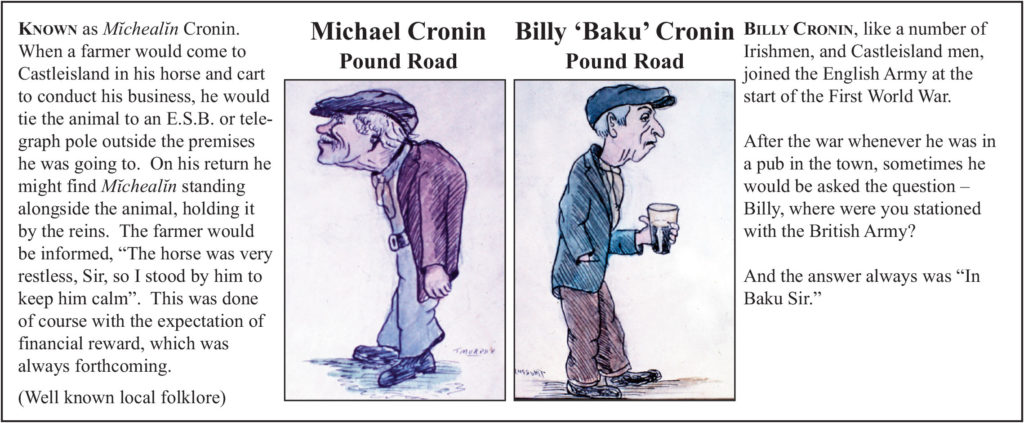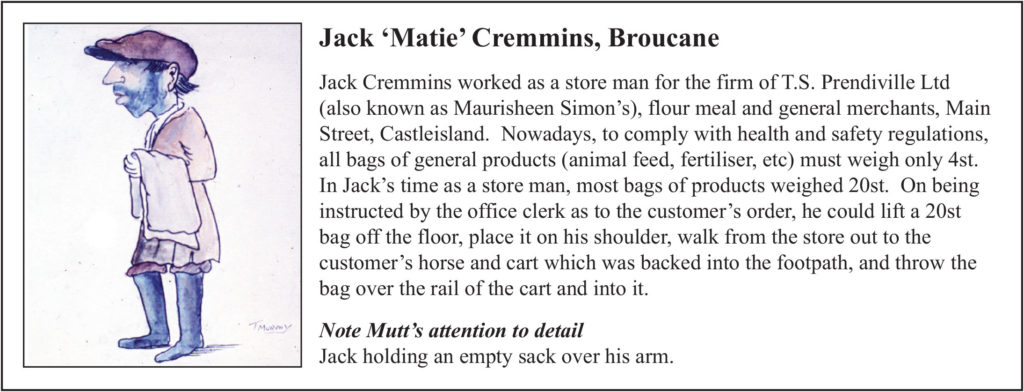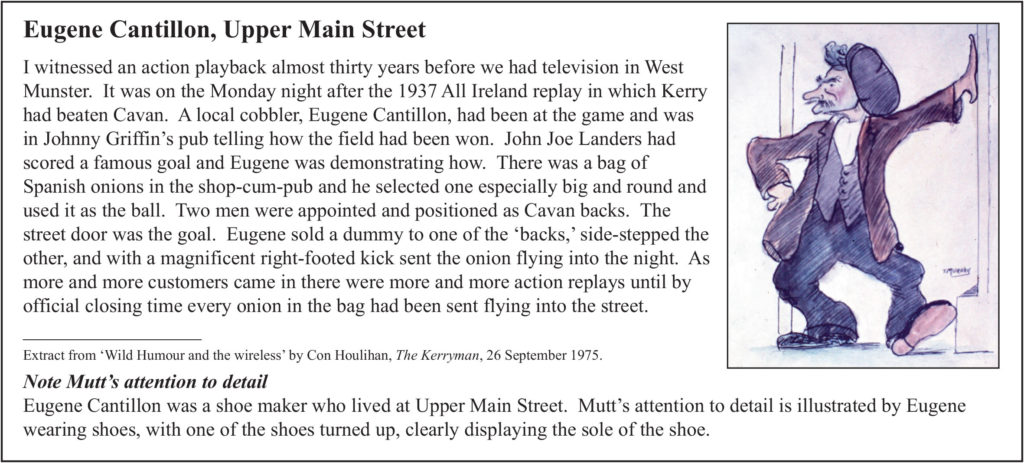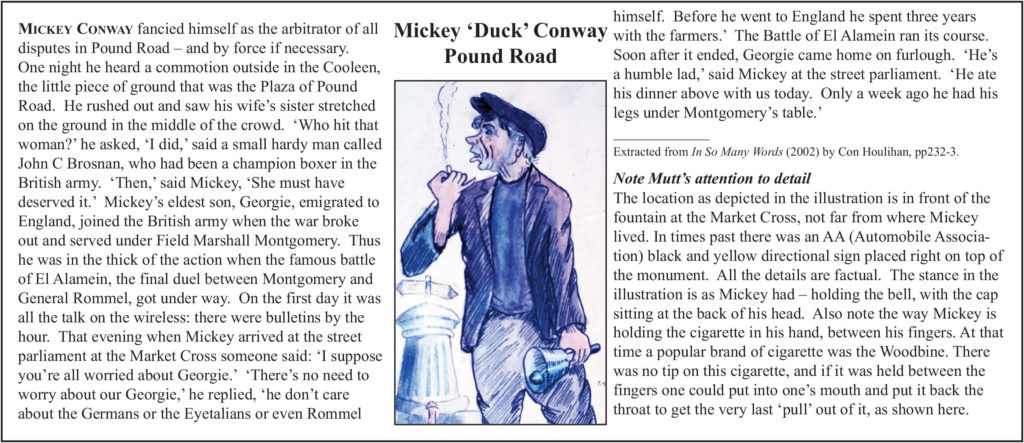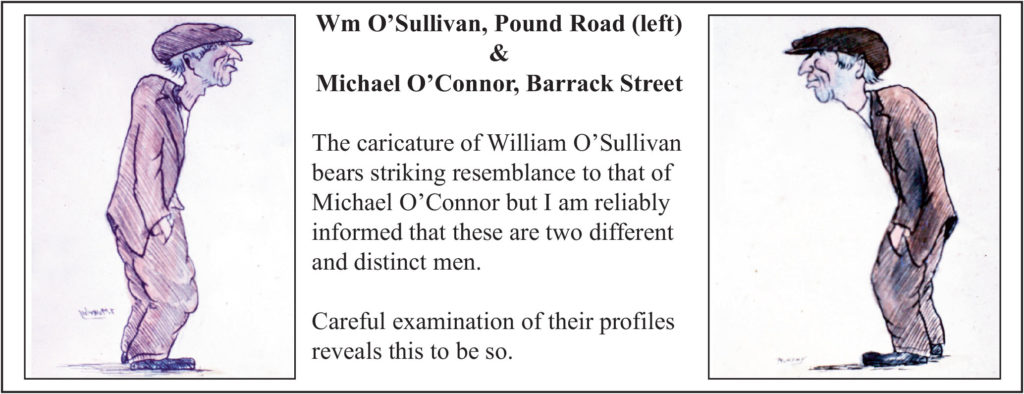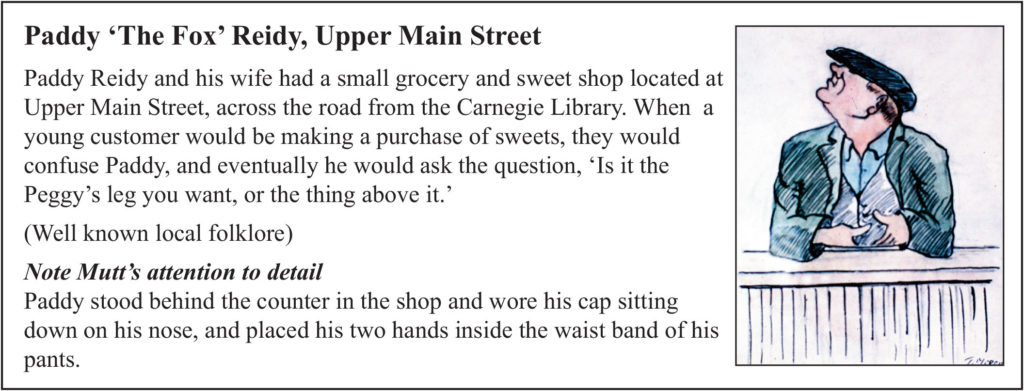Timothy Mutt Murphy was a popular painter, decorator and sign writer who lived with his family at 10 Castle Street, Killarney Road, Castleisland in the first half of the twentieth century. He was also an artist, and the artworks held by his family include depictions of lake scenes, children at play on the seashore, and still life. Mutt painted the ruins of Castleisland Castle, located close to his home, and the Town Crier at work in the 1940s and 50s.[1]

Mutt was friends with sculptor Francis (Frank) Xavier Hourigan and, it seems, studied at the National College of Art in the 1940s during the period Hourigan was teaching there.[2] Indeed, the portrait of him below, signed by Frank Hourigan, is a prized possession in the family.[3]

Mutt gained great popularity for a series of caricatures he produced depicting local characters from in and around Castleisland. Many of the artworks were displayed on the walls of shops and local businesses.

Mutt’s talents as a sign writer are displayed in the photograph below taken from Timothy Murphy’s photographic collection. It shows Charlie Lenihan, MCC, outside his butcher’s shop in Main Street, Castleisland. The mural (on the left of him) was the work of Mutt, though it has since been painted over.
Mutt’s versatility is also revealed when we learn that shortly before his death, he painted a caravan, Queen of the Highway, for Johnny Boy Flynn which won first prize for painted wagons at Puck Fair, Killorglin.
Timothy Mutt Murphy died suddenly in late November 1952.[4] A tribute shed a little light on his life within the community:
Castleisland was shocked on Friday morning to hear of the sudden death of Mr Timothy Murphy – one of the best known and most respected men in the town. There was scarcely any facet of activity in which he didn’t play an active part. He was President of the very active branch of the St Vincent de Paul Society of which he was a member since its foundation, first President of the Pioneers branch, a foundation member of the Castleisland Dramatic Players and one of their most successful actors, to mention only a few of his activities. By profession a painter, he was an artist at heart and very gifted. His fame as sign painter and commercial artist has spread far outside his native Kerry. The town is very much the poorer by his passing and the heartfelt sympathy of the people goes out to his widow and six young children.[5]
Timothy Murphy, Castleisland
Castleisland’s local historian, photographer – and Mutt’s namesake –Timothy Murphy (no relation to Mutt) has produced an article about the artist from his considerable collection of archive material, which includes photographs of a number of the rare caricatures, which he took in the 1980s.[6]
Timothy has cleverly married Mutt’s illustrations to what can be gathered from local lore, and also, in some instances, to the literature of author and journalist, Con Houlihan (1925-2012).[7] It is hoped that in so doing, more may be learned about Mutt– to help build a worthy biography.
Timothy Murphy: The Archive
Timothy attributes his interest in local history and photography to early inspiration from a school teacher in the town. In the late 1950s and early 1960s, Timothy attended St Patrick’s Boys’ Secondary (Scoil Naomh Pádraig), a privately owned school run by Tim Kerrisk and his wife Nora, known as “The Mrs.” Timothy described “The Mrs” as a formidable woman whose ideas on teaching and education were advanced for the time:
She always had at heart the interest of all the pupils in the school and did everything she could to prepare them for the road ahead after they left St Patrick’s. I have memories of her coming into a classroom to speak to the students on a certain topic addressing them as “Now, dear children.” Can you just imagine she going into the 6th class where a fair proportion of the boys would be 5ft-10ins, 5ft-11ins, and some even 6ft. plus.
Mrs Kerrisk taught geography and one morning came into the class room and announced that “today we are going to talk about environmental studies”:
We all looked at each other with our mouths open. What was she talking about? This was long before the Department of Education even dreamed up the subject.
Mrs Kerrisk suggested that her students investigate locally to see if there was anything of historical interest to be seen. To Timothy’s amazement, he discovered there were ruins of an old castle (Castleisland), an old church (St Stephen’s) and many other places of interest in his home town.
He was hooked. Timothy was, however, presented with the problem of acquiring a camera:
There was a photographer in the town at the time, the late Joseph O’Connell, Castleview, and it was he that set me up with my first camera. It was a small box camera with only use black-and-white film. But it worked for me.

Timothy described his progress in photography in the ensuing years. His uncle, Monsignor Denis Murphy, was a missionary in the Philippine Islands, and a keen photographer. He photographed his work in the mission fields, and during holidays home, showed the images to family and friends. Timothy recalls the impact this had on him:
He had a most interesting way of showing the images. He had what he called a slide projector and he would put his slides into this machine and project the enlarged image onto a screen, more often a big white bed sheet.
Monsignor Denis Murphy died suddenly in 1966 while working on the missions and when his personal effects were returned to the family, Timothy was given his camera. However, he found it difficult to operate: ‘I never really got the hang of being able to use it properly. One had to use a light meter with it and I could not get the hang of how to use that piece of equipment.’
In the early 1970s, a new type of a camera came on the market:
My technical adviser, and great friend, the late Ted Kennelly, our local chemist, helped me settle on a Pentax Spotmatic 500 35mm camera. It was a revolution in cameras. It had a built-in light meter and you switched this on by means of a switch on the camera. When you looked through the view-finder there was a needle on the left-hand side of it. For the correct exposure all that was required was to have this needle in the centre of the view finder. This was achieved by adjusting the speed at which the picture was to be taken. It could not have been easier. Ted also advised me on the type of slide projector to purchase, a Gaf 606. This projector took special roto-trays each containing 100 slides. It was an excellent machine.
In the years that followed, Timothy was taught how to frame and compose photographs by his first cousin, Tim Costello, who resides in Dublin (and at the time worked for RTE – Tim Costello spent a lot of his youth in Castleisland and took many slides, a considerable number of which are in Timothy’s possession).
Today’s digital age means that Timothy is presently engaged in copying his slides with the aid of a slide copier. His collection includes photographs, postcards, and other wide ranging material that has a bearing on Castleisland.

The descriptions below are the production of Timothy Murphy, who photographed the caricatures in the 1980s. Timothy can be contacted at timothy.murphy0@gmail.com or c/o the O’Donohoe archive.
____________________
[1]The role of the Town Crier, a means of advertising in earlier times, is described in Divane’s Calendar, 2007: ‘The Conway family were the first Town Criers, and were later succeeded by Michael Prendiville. The duties of the Town Crier were rich and varied, and were an integral part of buying and selling in Castleisland in the 1940s and 1950s.’ Further reference, O’Donohoe Collection reference IE MOD/C19. [2]Information courtesy Timothy Murphy, by letter from Mary O’Donoghue, daughter of Mutt Murphy, dated 13 January 2020. ‘Our mother has referred to his attending the National College of Art but I cannot find any record of this. He was friends with Frank Hourigan, sculptor, who painted the portrait of my father, enclosed. Frank Hourigan – according to the National Irish Visual Arts Library (NIVAL) taught sculpture at the National College of Art from 1942-1947 so it is possible that he and my father were together there – the dates fit!’ [3]Frank Hourigan was born on 6 May 1914 in Cork City, son of James Hourigan and Kate Moore of 45 Maddens Buildings, Watercourse Road, Blackpool (parish of St Anne’s Shandon) Cork. A little of Hourigan’s life can be gathered from an article published in the Ballina Herald, 31 January 1953 while he was working on the Castlebar 1798 monument unveiled later in that year: ‘Frank Hourigan was educated at the Farranferris Seminary and has a diploma of the School of Arts to the National College where he took his degree in 1938. He won the Giltinan and Gibson Scholarship but war broke out ... much of his work as freelance for some years after 1938 was executed for religious institutions. In 1944 he combined with Corkman F G Archer to produce a two man exhibition at Cork City Arts Club, opened by Lord Longford ... City Museum Davis Centenary his bronze bust of Irish leader still exhibited there ... In 1947 he came from Dun Laoghaire to Ballina to his present position as vocational art teacher to Ballina and Castlebar. He exhibits yearly in the Royal Academy, Oireachtais, and is still a member of the Munster Fine Arts Committee where he has also exhibited. His RHA exhibits include Mannan Mac Lir a composition of the fabled sea-god, and a dragon, Trathnoiia, a symbolic work; Miceal Pheig, a bronze bust of the Kerryman and The Famine, a figure composition 5’ high. His work on the Castlebar 1798 monument is a bronze plaque 2’ 6” x 4’ 2” which depicts Fr Conroy, the ’98 priest, who was hanged for his part in the rising, blessing a pike man. The entire monument will stand 14 feet high and will be faced with granite and bronze ... Many will have already noticed Mr Hourigan’s work in the oil landscape hanging in a well-known local hotel; another good example is the seascape in the possession of the Bishop of Galway.’ Hourigan, who was a member of ANCA (Associate of the National College of Art, Dublin, now NCAD) continued to exhibit at the Cork Arts Society Gallery. He retired from teaching in 1979. In 1983, at the 51st exhibition of the Munster Fine Arts Society at Crawford Municipal Art Gallery Cork ‘one of the most intriguing exhibits was a sculpture of composer Sean O Riada by F X Hourigan ANCA (by kind permission of Sean O’Sullivan).’ [4]Timothy Mutt Murphy was buried in Kilbannivane cemetery, Castleisland. The headstone there records the date, 28 November 1952. Newspaper notices of the death of Timothy Murphy of Killarney Road, Castleisland, recorded his date of demise as 27 November 1952. [5]Kerry Champion, 6 December 1952. [6]The illustrations of Mutt Murphy were photographed by Timothy Murphy in their frames on display in the home of Ted Murphy, Mutt’s son, who at the time worked in Galway City for the ESB. Timothy travelled to Galway in the early 1980s and met Ted, by appointment, and photographed the illustrations. Ted has since passed away. In 2012 Timothy considered making a DVD about the history of Castleisland. The DVD would contain Mutt’s illustrations, married with articles by Con Houlihan. Permission to use the illustrations was sought from Mutt’s family. This permission was readily granted. However, when the costs of producing the DVD and the market to which it would cater were examined, it was found that the production was not viable. [7]For further reference to Con Houlihan, see ‘Con Houlihan and The Taxpayers’ News’ at http://www.odonohoearchive.com/con-houlihan-and-the-taxpayers-news/


